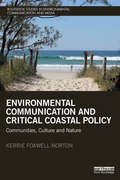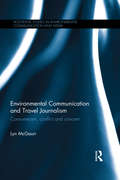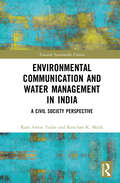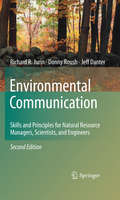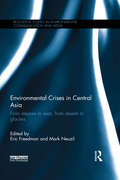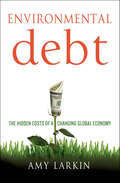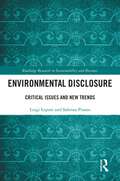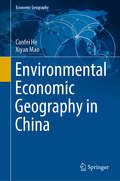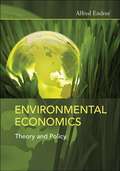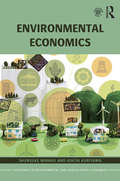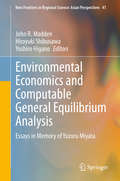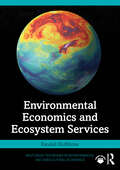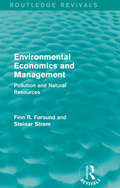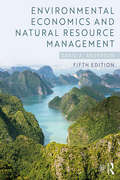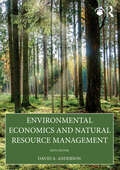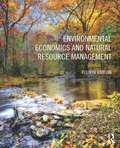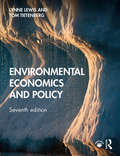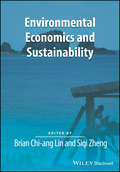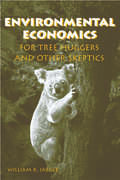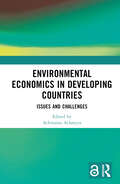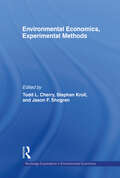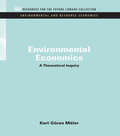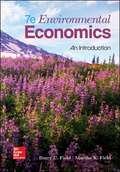- Table View
- List View
Environmental Communication and Critical Coastal Policy: Communities, Culture and Nature (Routledge Studies in Environmental Communication and Media)
by Kerrie Foxwell-NortonThe vast majority of the world’s population lives on or near the coast. These communities are an extraordinary and largely untapped resource that can be used to mitigate planetary disaster and foster environmental stewardship. Repeated waves of scientific fact and information are not inciting action, nor apparently producing enough momentum to change voting behaviour towards a progressive environmental politics. A critical coastal policy, underpinned by a deeper understanding of environmental communication, can offer something new to this status quo. Environmental Communication and Critical Coastal Policy argues that more science and ‘better’ communication has been largely responsible for the lacklustre response by citizens to environmental challenges. Foxwell-Norton asserts that the inclusion of a range of local meanings and cultural frameworks with which experts could engage would better incite participation in, and awareness of, local environmental issues. The value and possible role of ‘geo-community media’ (mainstream, alternative and social media) is examined here to illustrate and support the key argument that meaningful local engagement is a powerful tool in coastal management processes. This is a valuable resource for postgraduates, researchers and academics across environmental science and management, policy studies, communication studies and cultural studies.
Environmental Communication and Travel Journalism: Consumerism, Conflict and Concern (Routledge Studies in Environmental Communication and Media)
by Lyn McGaurrTravel journalism about natural attractions is environmental communication at the cusp of consumerism and concern. Countries and regions that market forests, rivers and wildlife to international tourists drive place-of-origin brand recognition that benefits exporters in other sectors. Place-branding in such destinations is not just PR for environmentally sustainable development and consumption, but also a political enterprise. Environmental Communication and Travel Journalism considers tourism public relations as elite reputation management, and applies models of political conflict and source-media relations to the analysis of the ‘soft’ genre of travel journalism. The book seeks to understand how, in whose interests and against what odds discourses of cosmopolitanism and place-branding influence the way travel journalists represent vulnerable and contested environments. Informed by interviews with journalists and their sources, Environmental Communication and Travel Journalism identifies and theorises networks, cultures, discursive strategies and multiple loyalties that can assist or interrupt flows of environmental concern in the cosmopolitan public sphere. The book should be of interest to scholars of environmental communication, environmental politics, journalism, tourism, marketing and public relations.
Environmental Communication and Water Management in India: A Civil Society Perspective (Towards Sustainable Futures)
by Kanchan K. Malik Ram Awtar YadavThis book analyses the underlying communication strategies and approaches of grassroots water management practices in India through a case study-based ethnographic approach. Drawing from fieldwork experiences, this volume provides a detailed overview of Parmarth, a not-for-profit NGO, which is the case study for this research. It presents an in-depth theoretically informed analysis of data collected through multiple methods, which includes key informant interviews, focus group discussions, participant observation, and document reviews, among other approaches. The book examines Parmarth’s strategies and processes to mobilise women as important stakeholders in the region’s water conservation initiatives. It discusses communicative actions, tactics and campaigns in water interventions and the role of various stakeholders ranging from local community members to civil society. Accessibly written, this volume is a must-read for scholars and researchers of media and communication studies, environmental communication, ecology studies, development studies, public policy, sustainable development, water management, sociology, and political science.
Environmental Communication. Second Edition: Skills and Principles for Natural Resource Managers, Scientists, and Engineers.
by Richard R. Jurin K. Jeffrey Danter Donny RoushEnvironmental professionals can no longer simply publish research in technical journals. Informing the public is now a critical part of the job. Environmental Communication demonstrates, step by step, how it's done, and is an essential guide for communicating complex information to groups not familiar with scientific material. It addresses the entire communications process, from message planning, audience analysis and media relations to public speaking - skills a good communicator must master for effective public dialogue. Environmental Communication provides all the knowledge and tools you need to reach your target audience in a persuasive and highly professional manner. "This book will certainly help produce the skills for environmental communications sorely needed for industry, government and non-profit groups as well as an informed public". Sol P. Baltimore, Director, Environmental Communications and Adjunct faculty, Hazardous Waste management program, Department of Chemical Engineering, College of Engineering, Wayne State University, Detroit, Michigan. "All environmental education professionals agree that the practice of good communications is essential for the success of any program. This book provides practical skills for this concern". Ju Chou, Associate Professor, Graduate Institute of Environmental Education National Taiwan Normal University Taipei, Taiwan
Environmental Crises in Central Asia: From steppes to seas, from deserts to glaciers (Routledge Studies in Environmental Communication and Media)
by Eric Freedman Mark NeuzilEnvironmental conditions do not exist in a vacuum. They are influenced by science, politics, history, public policy, culture, economics, public attitudes, and competing priorities, as well as past human decisions. In the case of Central Asia, such Soviet-era decisions include irrigation systems and physical infrastructure that are now crumbling, mine tailings that leach pollutants into soil and groundwater, and abandoned factories that are physically decrepit and contaminated with toxic chemicals. Environmental Crises in Central Asia highlights major environmental challenges confronting the region’s former Soviet republics: Kazakhstan, Kyrgyzstan, Tajikistan, Turkmenistan, and Uzbekistan. They include threats to the Caspian and Aral seas, the impact of climate change on glaciers, desertification, deforestation, destruction of habitat and biodiversity, radioactive and hazardous wastes, water quality and supply, energy exploration and development, pesticides and food security, and environmental health. The ramifications of these challenges cross national borders and may affect economic, political, and cultural relationships on a vast geographic scale. At the same time, the region’s five governments have demonstrated little resolve to address these complex challenges. This book is a valuable multi-disciplinary resource for academics, scholars, and policymakers in environmental sciences, geography, political science, natural resources, mass communications, public health, and economics.
Environmental Debt: The Hidden Costs of a Changing Global Economy
by Amy LarkinAn award-winning environmental activist and social entrepreneur exposes the link between our financial and environmental crisesFor decades, politicians and business leaders alike told the American public that today's challenge was growing the economy, and that environmental protection could be left to future generations. Now in the wake of billions of dollars in costs associated with coastal devastation from Hurricane Sandy, rampant wildfires across the West, and groundwater contamination from reckless drilling, it's becoming increasingly clear that yesterday's carefree attitude about the environment has morphed into a fiscal crisis of epic proportions. Amy Larkin has been at the forefront of the fight for the environment for years, and in Environmental Debt she argues that the costs of global warming, extreme weather, pollution and other forms of "environmental debt" are wreaking havoc on the economy. Synthesizing complex ideas, she pulls back the curtain on some of the biggest cultural touchstones of the environmental debate, revealing how, for instance, despite coal's relative fame as a "cheap" energy source, ordinary Americans pay $350 billion a year for coal's damage in business related expenses, polluted watersheds, and in healthcare costs. And the problem stretches far beyond our borders: deforestation from twenty years ago in Thailand caused catastrophic flooding in 2011, and cost Toyota 3.4 percent of its annual production while causing tens of thousands of workers to lose jobs in three different countries. To combat these trends, Larkin proposes a new framework for 21st century commerce, based on three principles: 1) Pollution can no longer be free; 2) All business decision making and accounting must incorporate the long view; and 3) Government must play a vital role in catalyzing clean technology and growth while preventing environmental destruction. As companies and nations struggle to strategize in the face of global financial debt, many businesses have begun to recognize the causal relationship between a degraded environment and a degraded bottom line. Profiling the multinational corporations that are transforming their operations with downright radical initiatives, Larkin presents smart policy choices that would actually unleash these business solutions to many global financial and environmental problems. Provocative and hard-hitting, Environmental Debt sweeps aside the false choices of today's environmental debate, and shows how to revitalize the economy through nature's bounty.
Environmental Disclosure: Critical Issues and New Trends (Routledge Research in Sustainability and Business)
by Luigi Lepore Sabrina PisanoThis book provides a description of the state of the art on environmental disclosure, illustrating the key theoretical issues, the regulatory frameworks, the main standards developed and reporting the results of an empirical analysis on the environmental disclosure released by listed firms. Luigi Lepore and Sabrina Pisano begin by analysing the origin and evolution of environmental disclosure. They go on to provide a description of the main theoretical frameworks used by scholars, explaining the conceptual basis of each theory and describing how the specific theory has been used to explain the company’s decision to release environmental disclosure. The second part of the book highlights the role and evolution of the European regulatory frameworks, emphasizing the transition from voluntary to mandatory disclosure. The book ends by providing a picture of the evolution of sustainability reporting practices in European Union nations over the past two decades. This book investigates the critical issues and new directions in environmental disclosure, which are currently under examination by regulators and standard setters. It will therefore be of great interest to academics and students working in the areas of business and sustainability.
Environmental Economic Geography in China (Economic Geography)
by Canfei He Xiyan MaoThis book contributes to the understanding of environment–economy relations from the perspective of economic geography, grounded in the institutional context of China. It demonstrates how classical economic geographies, new economic geographies, and geographies of economic globalization work together to affect the environment. It covers a series of classical topics like industrial location and industrial dynamics and some emerging fields like industrial evolution and global–local interaction and links them to environmental performance in China. The findings in this book echo the call for developing a more comprehensive and systematic research agenda of environmental economic geography. This book offers researchers, graduate students, and advanced undergraduate students in related fields both theoretical and practical considerations of environmental economic geography. It also offers insights into the policy-making relevant to China’s greening efforts.
Environmental Economics
by Iain L. Fraser Alfred EndresThis intermediate-level undergraduate textbook in environmental economics builds on the microeconomics courses students take in their first year. It intentionally does not survey the whole field or present every possible topic. Instead, there is a clear focus on the theory of environmental policy and its practical applications. Most of the applied parts of the book deal with the economics of environmental policy in the European Union and in the United States. The book combines basic environmental economic analysis, such as the internalization of externalities, with recent developments in this field, including induced technical change and coalition theory. Moreover, topics from daily policy debates such as global warming are put into economic perspective. This is done in an intelligible form for advanced undergraduate students of economics, business administration and related fields. Each part of the book contains a set of exercises and suggested solutions.
Environmental Economics
by Iain L. Fraser Alfred EndresThis intermediate-level undergraduate textbook in environmental economics builds on the microeconomics courses students take in their first year. It intentionally does not survey the whole field or present every possible topic. Instead, there is a clear focus on the theory of environmental policy and its practical applications. Most of the applied parts of the book deal with the economics of environmental policy in the European Union and in the United States. The book combines basic environmental economic analysis, such as the internalization of externalities, with recent developments in this field, including induced technical change and coalition theory. Moreover, topics from daily policy debates such as global warming are put into economic perspective. This is done in an intelligible form for advanced undergraduate students of economics, business administration, and related fields. Each part of the book contains a set of exercises and suggested solutions.
Environmental Economics (Routledge Textbooks in Environmental and Agricultural Economics)
by Shunsuke Managi Koichi KuriyamaThis book aids those concerned about environmental issues to firmly grasp relevant analytical methods and to comprehend the thought process behind environmental economics. It does so by drawing from specific environmental issues and at the same time providing commentary that facilitates understanding. This text contains in-depth explanations necessary for a thorough understanding of the fundamental aspects and importance of environmental economics. Environmental Economics seeks to elucidate the mechanisms that give rise to environmental problems by approaching environmental issues from an economic perspective. At the same time, it is a study aiming to indicate specific countermeasures that could resolve present environmental issues. This text has been put together in way that allows readers without specialized economics knowledge to easily understand the situation, issues and challenges of environmental economics.
Environmental Economics and Computable General Equilibrium Analysis: Essays in Memory of Yuzuru Miyata (New Frontiers in Regional Science: Asian Perspectives #41)
by John Madden Hiroyuki Shibusawa Yoshiro HiganoThis book addresses major issues such as a growing world energy demand, environmental degradation due to anthropogenic greenhouse gas (GHG) emission, and risk management of disastrous events such as pandemics, abnormal climate, and earthquakes. Using cutting-edge analytical tools, particularly computable general equilibrium (CGE) modelling, the analyses are focused on a very wide range of policy-relevant economic questions for the Asia-Pacific region, especially for Japan, China, India, Vietnam, and smaller nations, including Brunei, Timor Leste, and Fiji. The first part considers (a) the effects of climate change on agriculture sectors, energy policies, and future GHG emission trends, (b) adaptation to climate changes in energy policy and its impacts on the economies, and (c) risk management of catastrophic events such as global pandemics. The second part examines (a) energy environmental issues, (b) economic impacts of natural disaster and depopulation, and (c) effects of informatics development on risk management, using CGE modelling and other methods in regional science fields. Contributors are internationally active leading CGE modellers and environmental economists. The book should be greatly beneficial for scholars and graduate students as well as policy makers who are interested in the economic effects and management of risks relating to climate change and disastrous events.
Environmental Economics and Ecosystem Services (Routledge Textbooks in Environmental and Agricultural Economics)
by Randall BluffstoneEnvironmental Economics and Ecosystem Services provides a rigorous yet accessible introduction to environmental economics, using ecosystem services as the underlying framework. Assuming no prior knowledge of economics, and using a conversational writing style, the focus is on exploring society’s linkages with the environment and how economics can help solve key environmental problems.Structured in three parts, the book first introduces readers to the key theories in environmental economics and ecosystem services, and then explores the challenges of conservation. The final section examines environmental policy options, such as cap-and-trade, behavioral nudges, community-based natural resource management and carbon taxes. There is a strong international focus throughout the book, with real-life examples taken from North America, Europe, Asia, Africa and other regions. Students are supported by a range of pedagogical features, including chapter objectives, chapter summaries, discussion questions and further reading suggestions. In addition, the book offers worked examples, analytical problems and “Challenge Yourself” boxes to develop critical thinking skills. Lecture slides and answers to questions for discussion and practice problems are available for instructors.This is the ideal text for introductory courses in environmental economics, ecological economics, economics of sustainability, environmental management, environmental policy and ecosystem services.
Environmental Economics and Management: Pollution and Natural Resources (Routledge Revivals)
by Steinar Strøm Finn R FørsundFirst published in 1988, this book examines pollution and natural resources in relation to economic analysis. The section on pollution looks at areas such as the main problems in the field at the time, possible remedies and the environmental costs involved. In regards to natural resources, the book considers both the exploitation of non-renewable resources and commercial fishing. The non-technical introduction to the main problems set out in each chapter will appeal to the general reader whilst the formal models and more technical parts make the material equally suitable for more advanced students or those with specialist knowledge.
Environmental Economics and Natural Resource Management
by David A. AndersonThe tools of environmental economics guide policymakers as they weigh development against nature, present against future, and certain benefits against uncertain consequences. The policies and research findings explained in this textbook are relevant to decisions made daily by individuals, firms, and governments. This textbook offers instructors and students a user-friendly, relevant, and up-to-date introduction to these topics while covering recent advancements in the field and significant political and economic changes. The fifth edition has been thoroughly updated while retaining the story-based narratives and visual emphasis of previous editions, capturing students’ attention with full-color photos, graphs, and illustrations. It addresses the impact of changes in world leaders, national priorities, and international agreements along with key developments in the energy sector. These include the way hydraulic fracturing and the surging popularity of natural gas have revolutionized the fossil fuel industries; how new, green-energy technologies are bringing prices down and efficiency levels up; and the arrival of innovative energy sources such as ocean-thermal energy conversion. Environmental Economics and Natural Resource Management promotes environmental and economic literacy with policy-oriented, application-based content, all delivered in concise, accessible discussions. Through its engaging approach, the text brings the economic way of thinking into discussions of personal, community, corporate, and government activities that affect environmental assets and the quality of life.
Environmental Economics and Natural Resource Management
by David A. AndersonThe tools of environmental economics guide policymakers as they weigh development against nature, present against future, and certain benefits against uncertain consequences. The policies and research findings explained in this textbook are relevant to decisions made daily by individuals, firms, and governments. This textbook offers instructors and students a user-friendly, relevant, and up-to-date introduction to these topics while covering recent advancements in the field and significant political and economic changes.The book has been thoroughly updated while retaining the story-based narratives and visual emphasis of previous editions, capturing students’ attention with full-color photos, graphs, and illustrations. This sixth edition includes: Updated coverage of international environmental regulations, the effects of the COVID-19 pandemic on the environment, the effects of war on the environment, recent environmental summits and agreements, the evolving energy and transportation sectors, and trailblazing policies and research Expanded coverage of environmental issues and approaches in underrepresented countries and continents New discussions of EV batteries, populist leaders, carbon leakage, food waste, and ecological resilience Revised digital supplements, including a solutions guide, PowerPoints, and sample tests. Environmental Economics and Natural Resource Management promotes environmental and economic literacy with policy-oriented, application-based content delivered in concise, accessible discussions. Through its engaging approach, the text brings the economic way of thinking into discussions of personal, community, corporate, and government activities that affect environmental assets and the quality of life.
Environmental Economics and Natural Resource Management: And Natural Resource Management
by David A. AndersonThe tools of environmental economics guide policymakers as they weigh development against nature, present against future, and certain benefits against uncertain consequences. From reluctant-but-necessary calculations of the value of life, to quandaries over profits at the environment's expense, the policies and research findings explained in this textbook are relevant to decisions made daily by individuals, firms, and governments. The fourth edition of Environmental Economics and Natural Resource Management pairs the user-friendly approaches of the previous editions with the latest developments in the field. A story-based narrative delivers clear, concise coverage of contemporary policy initiatives. To promote environmental and economic literacy, we have added even more visual aids, including color photographs and diagrams unmatched in other texts. Ancillaries include an Instructor's Guide with answers to all of the practice problems and downloadable slides of figures and tables from the book. The economy is a subset of the environment, from which resources are obtained, workers and consumers receive sustenance, and life begins. Energy prices and environmental calamities constrain economic growth and the quality of life. The same can be said about overly restrictive environmental policies. It is with an appreciation for the weighty influence of this discipline, and the importance of conveying it to students, that this textbook is crafted.
Environmental Economics and Policy
by Lynne Lewis Thomas H. TietenbergEnvironmental Economics and Policy is a best-selling text for environmental economics courses. Offering a policy-oriented approach, it introduces economic theory, empirical fieldwork, and case studies that show how underlying economic principles provided the foundation for environmental policies. Key features include: Introductions to the theory and method of environmental economics, including externalities, benefit-cost analysis, valuation methods, and ecosystem goods and services. Extensive coverage of the major issues including climate change mitigation and adaptation, air and water pollution, and environmental justice. Boxed "Examples" and "Debates" throughout the text, which highlight global examples and major talking points. This text will be of use to undergraduate students of economics. Students will leave the course with a global perspective of how environmental economics has played and can continue to play a role in promoting fair and efficient environmental management. The text is fully supported with end-of-chapter summaries, discussion questions, and self-test exercises in the book. Additional online resources include references, as well as PowerPoint slides for each chapter.
Environmental Economics and Sustainability (Surveys of Recent Research in Economics)
by Siqi Zheng Brian Chi-ang LinEnvironmental Economics and Sustainability presents a collection of peer-reviewed research articles contributed by international experts that reveal the current state of our knowledge in the field of environmental economics. Presents the latest research results on a plethora of issues relating to environmental economics and sustainability Features original contributions from top experts in the field from around the world Addresses several of the contemporary challenges of sustainability while infusing new energy into the field of environmental economics Covers myriad topics relating to environmental economics and sustainability including climate change, air pollution, CO2 emissions, recycling, and the international environmental agreement
Environmental Economics for Tree Huggers and Other Skeptics
by William K. JaegerThough many students and environmentalists shudder at even the thought of economics, a working knowledge of the basics can be a powerful ally. Economic arguments carry a great deal of weight, and putting them to work for environmental causes can be a deciding factor, especially in policy debates. The reverse is true as well, and an understanding of the possibly flawed, misleading, or overstated economics behind an opponent's case can be crucially important. Environmental Economics for Tree Huggers and Other Skeptics carefully explains the tools of economic analysis and shows how they can be used to help reveal the root causes of and potential solutions for environmental and natural resource problems. Jaeger's proven techniques and wonderfully conversational tone assume no economics training, and his presentation of the material is designed to facilitate clarity. His step-by-step approach unearths surprisingly simple, easy-to-remember principles and shows how to apply them to real-world environmental problems. Those with exposure to introductory microeconomics will find Environmental Economics for Tree Huggers and Other Skeptics to be a welcome refresher. Undergraduate and graduate students of environmental studies, resource management, law, policy, and related fields, as well as novices who are skeptical of how the field could possibly help them in their own efforts, will be pleasantly surprised.
Environmental Economics in Developing Countries: Issues and Challenges
by Achiransu AcharyyaThe COVID-19 pandemic has laid bare the vulnerabilities of socio-economic systems globally and exposed the risks that natural capital degradation imposes on human health, economy, and society. This book studies the environmental challenges faced by developing economies in a post-COVID-19 world. Exploring diverse case studies from South Asia and Sub-Saharan Africa, the volume discusses the impact that economic development and, recently, COVID-19 has had on the environment, ecology, and economy of these regions. It analyses nature conservation policies aimed at minimizing ecological damage arising from economic development and discusses the policy objectives of sustainable development. It also highlights the significant role that environmental economics networks have played in capacity building, framing of policies using ecological economics tools, and developing a local leadership trained in addressing local sustainability issues. An important contribution to the study of environmental economics of the Global South, the book will be of interest to students and researchers of economics, environment, development studies, development economics, environmental policies, and South Asia studies. It will also be useful for policymakers and NGOs working in this field.
Environmental Economics, Experimental Methods (Routledge Explorations In Environmental Economics Ser.)
by Todd L. Cherry Stephan Kroll Jason ShogrenThe experimental method is one commonly applied to issues of environmental economics; this book brings together 63 leading researchers in the area and their latest work exploring the behavioural underpinnings of experimental environmental economics. The essays in this volume will be illuminating for both researchers and practitioners, specific
Environmental Economics: A Theoretical Inquiry (RFF Environmental and Resource Economics Set)
by Karl-Goran MalerFirst Published in 2011. Routledge is an imprint of Taylor & Francis, an informa company.
Environmental Economics: An Introduction (Seventh Edition)
by Barry C. Field Martha K. FieldEnvironmental Economics is an introduction to the basic principles of environmental economics as they have been developed in the past and as they continue to evolve. The examples discussed in this textbook represent only a sample of the full range of issues that actually exists. For this reason, the Seventh Edition sticks to the basic ideas and ways that environmental economists have found to make the basic concepts and models more specific and relevant to concrete environmental issues. The basic structure and sequence of chapters are unchanged but contain new and updated material that reflects the new research efforts by environmental economists over the last few years.
Environmental Economics: Concepts, Methods and Policies
by Matthias Ruth Dodo J. ThampapillaiEnvironmental Economics explores the ways in which economic theory and its applications, as practised and taught today, must be modified to explicitly accommodate the goal of sustainability and the vital role played by environmental capital.Pivoting around the first and second laws of thermodynamics, as well as the principles of ecological resilience, this book is divided into five key parts, which include extensive coverage of environmental microeconomics and macroeconomics. It drills down into issues and challenges including consumer demand; production and supply; market organisation; renewable and non-renewable resources; environmental valuation; macroeconomic stabilisation and international trade and globalisation. Drawing on case studies from forestry, water, soil, air quality and mining, this book will equip readers with skills that enable the analyses of environmental and economic policy issues with a specific focus on the sustainability of the economy. This new edition has been updated throughout and provides further coverage on topics such as energy transition, market organisation and the role of environmental economics in regulatory decision-making including critiques of contemporary policy directives like tradable pollution permits and net zero emissions. Challenges to achieving stabilisation and emission reduction have been expanded to include wars and conflicts such as those in the Middle East and the Russian invasion of Ukraine. This book further reinforces the premise that there are clear limits to growth and that modesty and moderation are superior alternatives.Rich in pedagogical features, including key concept boxes and review questions at the end of each chapter, this book will be a vital resource for upper-level undergraduate and postgraduate students studying not only environmental economics/ecological economics but also economics in general.
